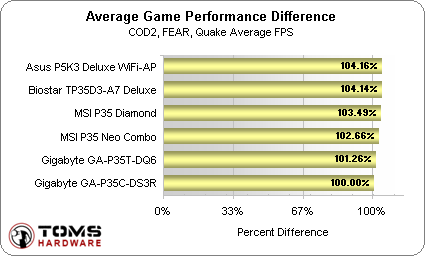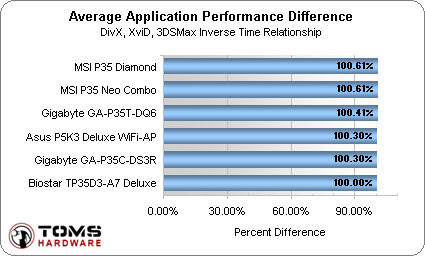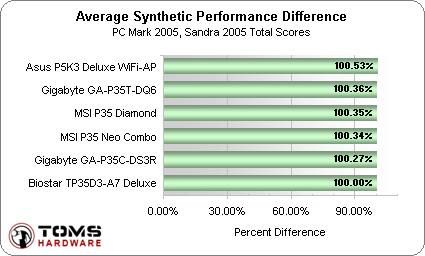Pipe Dreams: Six P35-DDR3 Motherboards Compared
Performance Summary
The most common "killer app" for draining wallets is games, so a percent overall difference between boards will let us see how well that money gets spent. Adding the average framerate for each game and dividing by the lowest result provides a 100% performance for the slowest system, by which percentages above 100% show performance gained.
Gigabyte's Call of Duty 2 quirk put a wider variation in motherboard gaming performance than previous reviews, but many hours of BIOS updates and system reinstalls were unable to address this one issue. We look forward to a quick solution from Gigabyte, and it is important to remember that this issue may be limited to a specific component in the test platform.
Asus leads in gaming by 4.16 percent over the "slowest" board, but its 0.06% lead over Biostar is far less than its nominal 0.24% overclock.
Next we add up the total encoding times for each board. Dividing every board into the highest time shows its performance increase as a percentage.
MSI leads in applications, with both its high-end and value-priced boards in a tie for number one.
Asus takes the lead back in Synthetics, with a "huge" 0.53% advantage over Biostar.
An average of previous scores will show the best overall performer.
Asus looks like a real winner with a 1.47% lead over the slower board, but what about its 0.24% overclock? Even after correcting for that it shows a 1.24% lead.
But Asus' 1.24% lead isn't really less than MSI's 1.29% lead, because MSI also overclocked the processor by 0.07%. Correcting for clock speed MSI's lead over the slowest board drops to 1.21%, 0.03% slower than Asus.
Both manufacturers must be doing an excellent job with BIOS if the performance difference has to be measured in hundredths of a percent. With performance difference between motherboards less than the performance difference "between runs" on the same board, it's impossible to make any fair determination from these scores.
It might be better to use overclocking results.
MSI takes the overclocking crown with its P35 Diamond, closely followed by the Gigabyte GA-P35T-DQ6. The dual-memory GA-P35C-DS3R also posts impressive results, edging out the enthusiast-class Asus P5K3 Deluxe WiFi-AP.
The MSI P35 Neo Combo is unfortunately not suited for high-speed overclocking, and the Biostar TP35D3-A7 Deluxe suffered from an early BIOS glitch that prevented overclocking at all. The Biostar design seems well suited for the task, so hopefully the company will resolve this issue in short order.
Get Tom's Hardware's best news and in-depth reviews, straight to your inbox.
-
Gigabyte GA-P35C-DS3R support up to 4GB DDR3 memory. However, could 8GBs 2x4GB DDR3 modules be used as long as it is within the top 1333 limit on the board?Reply





